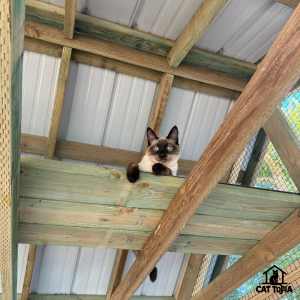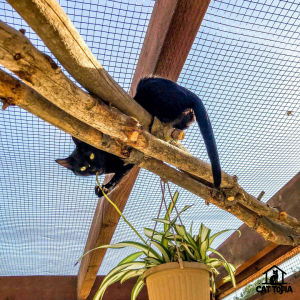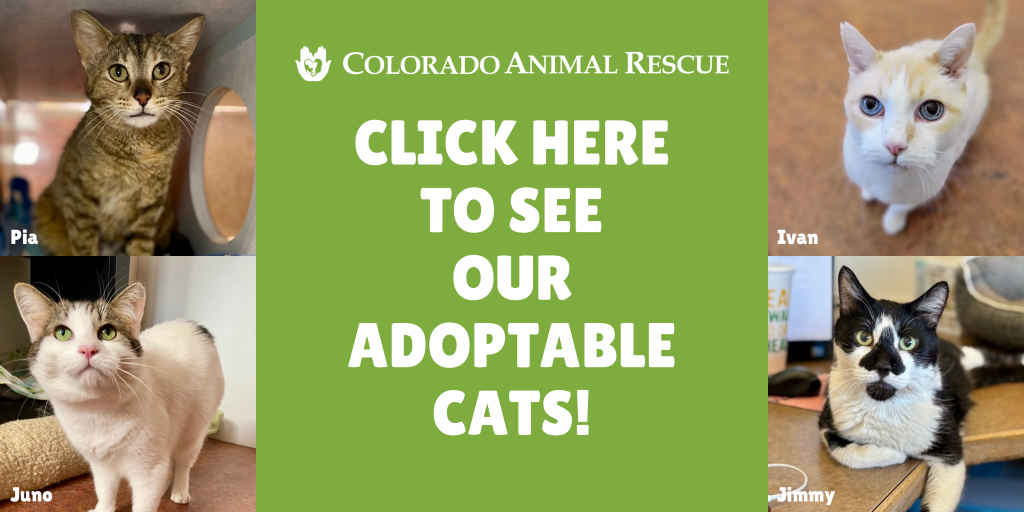How To Build Your Own Catio (For DIY Enthusiasts)
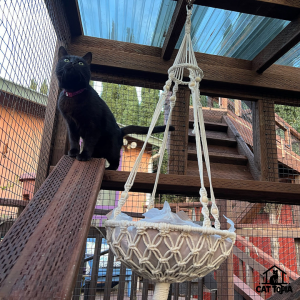
With warm weather approaching in Colorado, community and shelter dogs are excited for late-night walks and fun in the sun. But our feline friends are often left indoors for their safety and the safety of wildlife, like birds!
Fortunately, with a catio, your cat doesn’t have to be left out anymore! A catio—an enclosed outdoor patio designed specifically for cats—gives your kitty safe access to the outdoors without the risks of free roaming. It offers endless enrichment and stimulation, helping to keep your indoor cat happy, healthy, and engaged.
In this guide, our sponsors at Cat Topia will walk you through how to build your very own catio—covering the best types of lumber, screening, roofing, and the essential tools you’ll need to get started. Let’s turn that window view into a full outdoor experience for your feline companion!
The Benefits of a Catio
Catios are the purrfect way to let your indoor cat experience the outdoors safely—offering both physical and mental health benefits without exposing them to the dangers of free roaming.
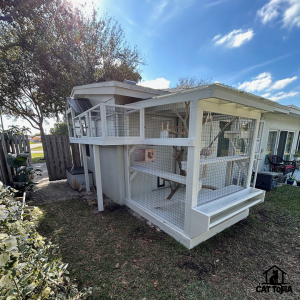
Physical Health Benefits:
- Improves Cardiovascular Health: Regular exercise in the catio helps strengthen the heart and promote healthy circulation.
- Enhances Joint Mobility: Stretching, climbing, and moving around the space supports flexibility—especially helpful for senior cats.
- Supports Bone Health: Physical activity helps maintain strong bones and overall musculoskeletal health.
Mental Health Benefits:
- Reduces Boredom: New sights, sounds, and scents stimulate your cat’s mind and prevent daily monotony.
- Eases Anxiety: Time spent in a natural, outdoor-like setting can relax and soothe an anxious cat.
- Prevents Depression: A more dynamic environment encourages exploration and adds variety to your cat’s day, boosting overall mood.
Why Cats Need Enrichment
With sharp senses and natural instincts to stalk, climb, and explore, cats need regular stimulation to stay mentally and physically healthy.
Without enrichment, cats may experience:
- Anxiety
- Depression
- Boredom
- Over-grooming
- Destructive behavior
- Excessive meowing
- Aggression

While these may be signs of a lack of enrichment, be sure to consult your veterinarian, as they could also indicate underlying health issues.
Choosing the Right Location
Selecting the perfect spot for your catio is key to creating a space your cat will love and use regularly. Start by considering the balance of sun and shade—cats enjoy lounging in the sun, but they also need shelter from intense heat. Easy access is another must; placing the catio near a frequently used window or door allows your cat to come and go with minimal effort, increasing the likelihood they’ll use the space often.
You’ll also want to think about visibility—both for your cat and for you. Choose a location where your cat can observe the yard or street activity to stay entertained, and where you can keep an eye on them from inside your home.
Catio location ideas include:
- Window box catio: Compact and ideal for small spaces or apartments.
- Porch conversion: Turns an existing porch into a multi-use area for you and your cat.
- Freestanding backyard enclosure: Offers more space and flexibility in design, great for larger properties.
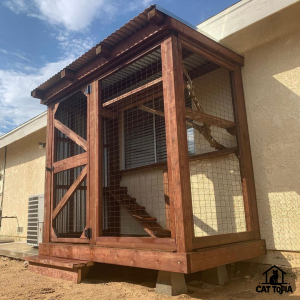
Best Materials for Building a Catio
Lumber
When building a catio, choosing the right lumber is essential for both durability and your cat’s safety. Opt for weather-resistant woods like cedar or pressure-treated lumber, which can withstand the elements and last for years. Be sure to avoid toxic options, such as certain treated pines, which may contain chemicals harmful to pets.
- Cedar: Naturally weather-resistant, non-toxic, and insect-repellent—ideal for outdoor use and safe for cats.
- Pressure-Treated Wood: Treated to resist rot and pests; great for longevity, but make sure it’s labeled pet-safe and avoid using it on interior surfaces your cat may lick or scratch.
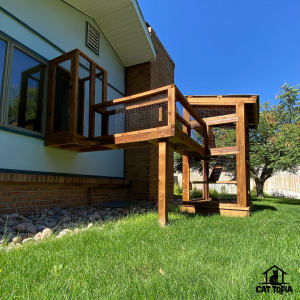
- Redwood: Durable and resistant to decay, though often more expensive—excellent for a long-lasting, attractive build.
- Douglas Fir (sealed): Affordable and strong, but must be properly sealed to protect against weather and wear.
Screening
Screening is one of the most important components of your catio—it keeps your cat safely inside while keeping predators and pests out. The best screening materials are durable, weather-resistant, and designed to withstand claws, bites, and the elements. It’s also important to consider visibility, airflow, and long-term wear.
- 1×1 Black Welded Wire Fence: A popular choice for catios; strong, rust-resistant, and blends in well visually, allowing clear views for both you and your cat.

- Galvanized Steel Fencing: Extremely durable and predator-proof; ideal for areas with raccoons, coyotes, or other wildlife threats. Be sure to choose a mesh size small enough to prevent escape.
- Double Screening with Cat-Resistant Pet Screen: For extra security, layer standard hardware cloth with pet-specific screening. Pet screen is made from vinyl-coated polyester, which resists tearing and claw damage—great for cats who love to scratch.
Tip: Always check that your screening is tightly secured and framed properly to prevent bending, gaps, or weak spots.
Roofing
A well-built catio should provide comfort and protection in all seasons. The right roofing keeps your cat shaded, dry, and safe from harsh weather, while quality flooring ensures comfort, traction, and easy cleanup. Choose materials that are durable, weather-resistant, and pet-safe, while also considering ventilation and visibility.
- Polycarbonate Panels: Lightweight, UV-resistant, and highly durable. These panels offer excellent weather protection while still letting in natural light—perfect for sunny loungers.
- Corrugated Plastic or PVC Roofing: A budget-friendly option that’s easy to install and water-resistant. Great for mild climates, but may not be as durable in extreme weather.
- Metal Roofing (Aluminum or Tin): Extremely sturdy and long-lasting. Best for large catios or areas with heavy snow or rain. Be aware it can heat up in direct sun, so combine with shade panels or insulation.
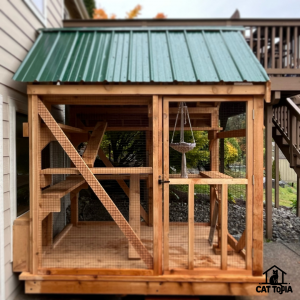
- Clear Acrylic or Plexiglass Panels: Sleek and transparent, ideal for modern catios that need full visibility. These offer solid weather resistance but may scratch more easily than other options.
Tip: Always check that roofing is securely attached and sloped to allow for proper water drainage.
Fasteners and Hardware
The strength and safety of your catio depend heavily on the quality of the fasteners and hardware you choose. From framing to doors, using rust-resistant, pet-safe, and secure components will ensure your catio stands strong through all seasons and keeps your feline safely contained.
- Rust-Resistant Screws: Choose stainless steel or galvanized screws to prevent rust and corrosion, especially in outdoor and wet environments. Essential for long-term durability.
- Exterior-Grade Hinges: Heavy-duty, rust-proof hinges are best for catio doors and access points. Look for ones rated for outdoor use to avoid squeaking and wear.
- Corner Brackets or Angle Braces: Reinforce corners and connections for extra structural support, particularly on larger or freestanding catios.
Tip: Always double-check that all hardware is tightly secured and free of sharp edges or exposed points that could injure your cat.
Safety Considerations
When building a catio, safety should always be the top priority. A well-built, secure structure keeps your cat protected outdoors and gives you peace of mind in all weather conditions.
- Structural Stability: Make sure your catio is solid and secure, especially if you live in areas prone to high winds, heavy snow, or storms. Use strong framing materials and anchoring where needed to prevent collapse or tipping.
- Escape-Proofing Techniques: Double-check for gaps, loose screens, or unsecured doors that a curious cat could squeeze through. Use tight mesh sizes and secure latches to prevent breakouts.
- Non-Toxic Paints & Sealants: If you’re sealing or painting your catio, choose products labeled pet-safe and non-toxic. Avoid finishes that chip, peel, or contain harmful chemicals.
- Regular Maintenance Checks: Inspect your catio regularly for wear and tear—loose fasteners, splintered wood, rust, or sagging mesh—and make repairs promptly to ensure ongoing safety.
Tip: Always observe your cat’s behavior in the catio early on. If they’re fixated on one corner or testing a weak spot, reinforce it before it becomes a problem.
Why a Catio is the Purrfect Solution for Indoor Cats
Building your own catio is more than just a DIY project—it’s a meaningful way to improve your cat’s quality of life while enjoying the satisfaction of creating something with your own hands. With the right materials, thoughtful planning, and a little creativity, you can give your indoor cat the freedom to safely explore the outdoors, stay active, and feel enriched every single day.
Whether you start small with a window box or go big with a backyard enclosure, your cat will thank you with endless purrs, playful moments, and peaceful sunbathing sessions. So roll up your sleeves and start building—because your cat’s world is only as big as you make it, so make it big!
